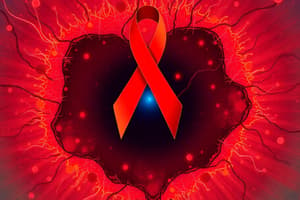Podcast
Questions and Answers
In a diagnostic microbiology laboratory, which activity primarily falls under the clinical service aspect?
In a diagnostic microbiology laboratory, which activity primarily falls under the clinical service aspect?
- Developing new methods for identifying microbial species.
- Providing routine diagnostic testing for patient samples. (correct)
- Training new laboratory staff in advanced techniques.
- Conducting research on emerging infectious diseases.
A researcher is investigating the effectiveness of a new antiviral drug. Which section of the diagnostic microbiology laboratory would most likely be involved in this research?
A researcher is investigating the effectiveness of a new antiviral drug. Which section of the diagnostic microbiology laboratory would most likely be involved in this research?
- Bacteriology
- Mycology
- Parasitology
- Virology (correct)
A patient is suspected of having a chronic parasitic infection, but initial tests are inconclusive. Which type of sample analysis would be most useful in determining the duration and extent of the patient's immune response?
A patient is suspected of having a chronic parasitic infection, but initial tests are inconclusive. Which type of sample analysis would be most useful in determining the duration and extent of the patient's immune response?
- Bacterial Culture
- Serology (correct)
- Fungal Stain
- Viral Load
A microbiology lab is investigating an outbreak of a new fungal infection. To accurately identify the causative agent, which characteristic is MOST critical to analyze?
A microbiology lab is investigating an outbreak of a new fungal infection. To accurately identify the causative agent, which characteristic is MOST critical to analyze?
In optimizing the pre-analytic phase of diagnostic microbiology, what is the MOST critical step to ensure accurate test results?
In optimizing the pre-analytic phase of diagnostic microbiology, what is the MOST critical step to ensure accurate test results?
A technologist notices a delay in reporting test results due to inefficient data entry. Which action would MOST effectively optimize the post-analytical process?
A technologist notices a delay in reporting test results due to inefficient data entry. Which action would MOST effectively optimize the post-analytical process?
During a lab tour, you observe separate rooms for different types of analyses. Which organizational layout BEST minimizes the risk of cross-contamination?
During a lab tour, you observe separate rooms for different types of analyses. Which organizational layout BEST minimizes the risk of cross-contamination?
In a Gram stain procedure, if the alcohol decolorizer is skipped, what would be the likely appearance of both Gram-positive and Gram-negative bacteria under the microscope?
In a Gram stain procedure, if the alcohol decolorizer is skipped, what would be the likely appearance of both Gram-positive and Gram-negative bacteria under the microscope?
Why is culture considered more sensitive than direct detection methods like Gram staining?
Why is culture considered more sensitive than direct detection methods like Gram staining?
In the context of laboratory testing, which of the following best describes the 'pre-analytical' phase?
In the context of laboratory testing, which of the following best describes the 'pre-analytical' phase?
In MALDI-TOF mass spectrometry, what is the primary role of the 'matrix' chemical?
In MALDI-TOF mass spectrometry, what is the primary role of the 'matrix' chemical?
Which step in the MALDI-TOF process directly results in the creation of a unique 'fingerprint' for bacterial identification?
Which step in the MALDI-TOF process directly results in the creation of a unique 'fingerprint' for bacterial identification?
A microbiologist observes a bacterial sample under a microscope after performing a Gram stain. The bacteria appear purple. Which of the following conclusions can be accurately drawn?
A microbiologist observes a bacterial sample under a microscope after performing a Gram stain. The bacteria appear purple. Which of the following conclusions can be accurately drawn?
A lab technician is tasked with rapidly identifying a fungal infection from a patient sample. Which direct detection method would be most appropriate for this purpose?
A lab technician is tasked with rapidly identifying a fungal infection from a patient sample. Which direct detection method would be most appropriate for this purpose?
Why is the 'Time of Flight' component important in MALDI-TOF mass spectrometry?
Why is the 'Time of Flight' component important in MALDI-TOF mass spectrometry?
Why is electron microscopy particularly useful in virology for direct detection of viruses?
Why is electron microscopy particularly useful in virology for direct detection of viruses?
What is a primary disadvantage of using syndromic testing as a rapid diagnostic method?
What is a primary disadvantage of using syndromic testing as a rapid diagnostic method?
What characteristic of PCR tests makes them particularly useful for diagnosing C. difficile infections?
What characteristic of PCR tests makes them particularly useful for diagnosing C. difficile infections?
Which of the following statements is correct regarding the turnaround time (TAT) and sensitivity of direct detection methods versus culture methods?
Which of the following statements is correct regarding the turnaround time (TAT) and sensitivity of direct detection methods versus culture methods?
In the context of PCR testing, what is the role of primers?
In the context of PCR testing, what is the role of primers?
A microbiologist performs a Gram stain on a sample from a patient suspected of having a bacterial infection, but no organisms are seen on the smear. According to protocol, what is the next appropriate step?
A microbiologist performs a Gram stain on a sample from a patient suspected of having a bacterial infection, but no organisms are seen on the smear. According to protocol, what is the next appropriate step?
In biochemical identification of bacteria, what principle is used to identify the specific type of bacteria?
In biochemical identification of bacteria, what principle is used to identify the specific type of bacteria?
What is a significant risk associated with performing PCR tests?
What is a significant risk associated with performing PCR tests?
How does MALDI-TOF differentiate between different species of bacteria?
How does MALDI-TOF differentiate between different species of bacteria?
What is the significance of using rapid diagnostic methods in clinical settings?
What is the significance of using rapid diagnostic methods in clinical settings?
Prior to placing the target plate inside the MALDI-TOF machine, what is the last preparatory step?
Prior to placing the target plate inside the MALDI-TOF machine, what is the last preparatory step?
A physician orders a third set of blood cultures (total of six bottles) for a patient to rule out bacteremia. Which of the following statements BEST reflects the appropriateness of this order, considering resource utilization and diagnostic yield?
A physician orders a third set of blood cultures (total of six bottles) for a patient to rule out bacteremia. Which of the following statements BEST reflects the appropriateness of this order, considering resource utilization and diagnostic yield?
A patient without urinary tract symptoms has a urine dipstick test ordered as part of a routine check-up, prior to a more extensive examination. According to recommendations for avoiding unnecessary resource consumption, what is the MOST appropriate course of action?
A patient without urinary tract symptoms has a urine dipstick test ordered as part of a routine check-up, prior to a more extensive examination. According to recommendations for avoiding unnecessary resource consumption, what is the MOST appropriate course of action?
A doctor preemptively orders several lab tests, including a complete blood count and metabolic panel, anticipating that their supervising physician would want them. What principle of avoiding unnecessary resource consumption does this violate?
A doctor preemptively orders several lab tests, including a complete blood count and metabolic panel, anticipating that their supervising physician would want them. What principle of avoiding unnecessary resource consumption does this violate?
When collecting blood cultures to diagnose a bloodstream infection, what is the MOST critical factor to ensure accurate results?
When collecting blood cultures to diagnose a bloodstream infection, what is the MOST critical factor to ensure accurate results?
What is the MOST important instruction to give a patient who needs to provide a sputum sample for laboratory analysis?
What is the MOST important instruction to give a patient who needs to provide a sputum sample for laboratory analysis?
Which of the following methods directly identifies the type of bacteria present in a sample using fluorescent markers?
Which of the following methods directly identifies the type of bacteria present in a sample using fluorescent markers?
In a laboratory setting, during which phase does specimen collection take place?
In a laboratory setting, during which phase does specimen collection take place?
If a lab technician receives a poorly collected specimen, which of the following is the most likely consequence based on the principle of 'garbage in, garbage out'?
If a lab technician receives a poorly collected specimen, which of the following is the most likely consequence based on the principle of 'garbage in, garbage out'?
Resource stewardship in healthcare aims primarily to reduce which of the following?
Resource stewardship in healthcare aims primarily to reduce which of the following?
A doctor is considering ordering an expensive and invasive diagnostic test before exploring less invasive options. According to resource stewardship principles, what should a lab professional do?
A doctor is considering ordering an expensive and invasive diagnostic test before exploring less invasive options. According to resource stewardship principles, what should a lab professional do?
How does unnecessary testing impact access to healthcare for other patients?
How does unnecessary testing impact access to healthcare for other patients?
During which of the following phases of laboratory testing does the interpretation of test results occur?
During which of the following phases of laboratory testing does the interpretation of test results occur?
After analysis of the specimen is complete, in which phase does the lab report become available?
After analysis of the specimen is complete, in which phase does the lab report become available?
Which action exemplifies resource stewardship by a clinical lab professional?
Which action exemplifies resource stewardship by a clinical lab professional?
A lab technician notices an unusual test request that seems inappropriate for the patient's condition. What is the BEST course of action?
A lab technician notices an unusual test request that seems inappropriate for the patient's condition. What is the BEST course of action?
Flashcards
Diagnostic Microbiology
Diagnostic Microbiology
The in vitro diagnosis of diseases caused by microorganisms (bacteria, fungi, viruses, parasites, and mycobacteria).
Diagnostic Microbiology Lab Roles
Diagnostic Microbiology Lab Roles
Routine diagnostics, infection control, and reference testing.
Bacteriology
Bacteriology
The study of bacteria, which are prokaryotic, single-celled organisms divided into Gram-positive and Gram-negative types.
Mycology
Mycology
Signup and view all the flashcards
Virology
Virology
Signup and view all the flashcards
Serology
Serology
Signup and view all the flashcards
Parasitology
Parasitology
Signup and view all the flashcards
Mycobacteriology
Mycobacteriology
Signup and view all the flashcards
Acid-Fast Bacteria (AFB)
Acid-Fast Bacteria (AFB)
Signup and view all the flashcards
Gram Stain Steps
Gram Stain Steps
Signup and view all the flashcards
Calcofluor White
Calcofluor White
Signup and view all the flashcards
Electron Microscopy
Electron Microscopy
Signup and view all the flashcards
Culture (Microbiology)
Culture (Microbiology)
Signup and view all the flashcards
Agar Plate Streaking
Agar Plate Streaking
Signup and view all the flashcards
Biochemical Identification (Bacteria)
Biochemical Identification (Bacteria)
Signup and view all the flashcards
Direct Detection vs. Culture
Direct Detection vs. Culture
Signup and view all the flashcards
Unnecessary Resource Use
Unnecessary Resource Use
Signup and view all the flashcards
Eliminate Low-Value Healthcare
Eliminate Low-Value Healthcare
Signup and view all the flashcards
Blood Culture Volume
Blood Culture Volume
Signup and view all the flashcards
Blood Culture Sets
Blood Culture Sets
Signup and view all the flashcards
Quality Sputum Sample
Quality Sputum Sample
Signup and view all the flashcards
Virus Identification (clear = 0)
Virus Identification (clear = 0)
Signup and view all the flashcards
MALDI-TOF Mass Spectrometry
MALDI-TOF Mass Spectrometry
Signup and view all the flashcards
Steps of MALDI-TOF
Steps of MALDI-TOF
Signup and view all the flashcards
Rapid Diagnostics Characteristics
Rapid Diagnostics Characteristics
Signup and view all the flashcards
Syndromic Testing
Syndromic Testing
Signup and view all the flashcards
Downside of Syndromic Testing
Downside of Syndromic Testing
Signup and view all the flashcards
PCR Test
PCR Test
Signup and view all the flashcards
PCR as Point of Care
PCR as Point of Care
Signup and view all the flashcards
PCR Sensitivity and Specificity
PCR Sensitivity and Specificity
Signup and view all the flashcards
PCR Amplification
PCR Amplification
Signup and view all the flashcards
Amplified DNA Detection
Amplified DNA Detection
Signup and view all the flashcards
Susceptibility Testing
Susceptibility Testing
Signup and view all the flashcards
Pre-analytical Phase
Pre-analytical Phase
Signup and view all the flashcards
Analytical Phase
Analytical Phase
Signup and view all the flashcards
Post-analytical Phase
Post-analytical Phase
Signup and view all the flashcards
Critical Role in Pre-analytics
Critical Role in Pre-analytics
Signup and view all the flashcards
"Garbage In, Garbage Out"
"Garbage In, Garbage Out"
Signup and view all the flashcards
Resource Stewardship
Resource Stewardship
Signup and view all the flashcards
Unnecessary Harm
Unnecessary Harm
Signup and view all the flashcards
Limitation of Access
Limitation of Access
Signup and view all the flashcards




